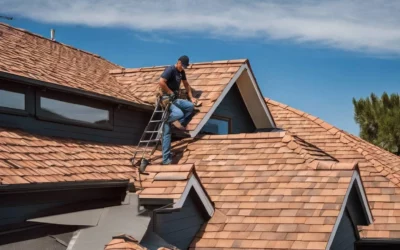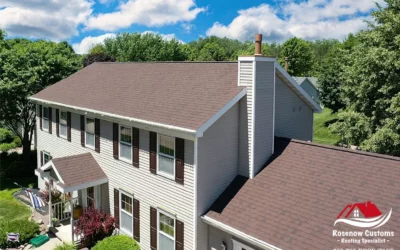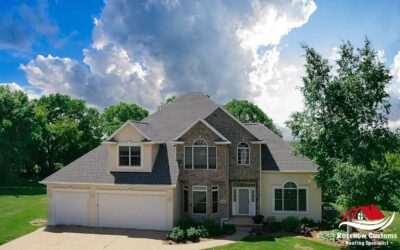Is your roof just another part of your house, or could it be the crown jewel that enhances your home’s curb appeal and durability? Choosing the right roofing material can feel overwhelming, but understanding your options makes the decision easier. DECRA stone-coated metal roofing and traditional metal roofing are two outstanding choices, each offering unique benefits for homeowners.
At Rosenow Customs, we specialize in installing DECRA stone-coated metal roofing, providing homeowners with a stylish, durable, and long-lasting roofing solution. This comprehensive guide will explore these two roofing solutions, compare their features, and help you determine which option suits your needs. By the end, you’ll be well-equipped to make an informed decision about your next roof.
What Is DECRA Stone-Coated Metal Roofing?
DECRA stone-coated metal roofing is a stone-coated metal shingle that combines the strength of steel roof with the aesthetic appeal of traditional roofing materials. This innovative roofing solution offers a durable yet stylish option for homeowners looking to enhance their property.
- Construction Process:
- A galvanized steel base ensures superior strength.
- Acrylic resin coats the steel for added durability.
- Natural stone granules create a beautiful finish, mimicking asphalt shingles, tiles, or shakes.
- Available Styles:
- DECRA Villa Tile: Classic barrel-style shapes for Mediterranean-inspired homes.
- DECRA Shake XD: Rustic charm with the durability of steel.
- Key Benefits:
- Mimics traditional roofing materials like shingles, clay tiles or wood shakes.
- Versatile enough to suit a wide range of architectural styles.
- Long-lasting performance with minimal maintenance.

What Is Traditional Metal Roofing?
Traditional metal roofing is a versatile and reliable option, metal roofing offers a sleek, modern design and has exceptional durability. Metal roofing products is typically made from various types of metal such as steel, aluminum, or copper, this roofing type has become a popular choice for both residential and commercial properties.
- Common Types:
- Standing Seam Metal Roofing: Raised seams create a clean, contemporary look.
- Corrugated Metal Panels: Cost-effective and often used for industrial or agricultural applications.
- Primary Features:
- Lightweight and easy to install.
- Low-maintenance and resistant to extreme weather.
- Modern aesthetics for minimalist or industrial home designs.
- Benefits:
- Exceptional longevity, often lasting 40-70 years.
- Energy efficiency due to heat reflectivity.
- Recyclable and environmentally friendly.
Comparing Performance: Durability and Longevity
DECRA Stone-Coated Metal Roofing Durability
DECRA metal roofing systems are designed to withstand some of the toughest environmental challenges:
- Hail Resistance: The stone-coating layer adds an extra shield against impact damage.
- Wind Resistance: Can withstand winds up to 120 mph.
- Fire Resistance: Class A fire rating ensures safety.
- Longevity: DECRA roofs last 40-70 years with minimal wear and tear.
Traditional Metal Roofing Durability
While the benefits of metal roofs excel in performance, they face different challenges:
- Weather Resistance: Handles snow, rain, and high winds with ease.
- Susceptibility: Risk of corrosion or color fading without proper coatings.
- Longevity: Often matches DECRA’s lifespan, though maintenance needs may vary.
Aesthetic Appeal and Customization
DECRA’s Aesthetic Edge
DECRA stone-coated metal roofing offers the ability to replicate traditional roofing styles while providing superior performance.
- Wide Range of Styles:
- Shingle like panels for a classic look.
- Barrel tiles for Mediterranean elegance.
- Wood shake designs for rustic charm.
- Color Options: Available in a variety of hues and textures to complement your home’s architecture.
Traditional Metal Roofing Design
- Best suited for modern or industrial home designs.
- Limited stylistic variety compared to DECRA.
- Available in numerous colors but lacks the texture variety of stone-coated options.
Energy Efficiency and Environmental Impact
Energy Efficiency
Both DECRA and traditional metal roofs are classed as energy-efficient roofing materials, but DECRA has a slight edge due to its stone coating:
- DECRA: Reflects heat and incorporates infrared pigments for increased solar reflectance.
- Traditional Metal Roofs: Reflects sunlight, reducing cooling costs but without additional coatings for enhanced efficiency.
Environmental Impact
- DECRA:
- Uses recyclable materials.
- Long lifespan reduces waste.
- Eco-friendly production processes.
- Traditional Metal Roofs:
- Often made from recycled metals.
- Fully recyclable at the end of their lifespan.
| Feature | DECRA Stone-Coated | Traditional Metal |
|---|---|---|
| Energy Efficiency | High | Moderate |
| Recyclability | Yes | Yes |
| Eco-Friendly Production | Yes | Yes |
Installation and Maintenance: DECRA Metal Roof vs Traditional Metal Roof
Installation Complexity
- DECRA: Requires skilled professionals due to its interlocking panel system and stone-coating.
- Traditional Metal Roofs: Simpler to install but demands precision to avoid future issues.
Maintenance
- DECRA:
- Minimal cleaning required.
- Stone coating helps absorb noise from rain or hail.
- Traditional Metal Roofs:
- Periodic inspections for rust and sealant degradation.
- May require repainting or resealing over time.

Cost Analysis: Is It Worth the Investment?
Upfront Costs
- DECRA Stone-Coated Metal Roofs:
- Typically higher initial investment.
- Costs range between $10.50-$18.50 per square foot.
- Traditional Metal Roofs:
- More affordable upfront.
- Costs range between $8-$14 per square foot.
Long-Term Value
- DECRA roofs offer significant ROI through:
- Reduced energy bills.
- Longevity and minimal repairs.
- Enhanced home value.
- Traditional metal roofs also provide good value but may incur higher maintenance costs over time.
Which Option Is Right for Your Home?
Consider these factors to determine the best fit for your needs:
- Climate:
- DECRA excels in areas with diverse weather conditions.
- Traditional metal roofing thrives in extreme heat or cold.
- Architectural Style:
- Choose DECRA for versatility.
- Opt for traditional metal roofing for modern, sleek designs.
- Budget:
- DECRA suits long-term investments.
- Traditional metal roofing is ideal for immediate affordability.
Testimonials and Case Studies
Satisfied Customers:
- A homeowner in Wisconsin replaced their aging roof with DECRA Villa Tile. The result? “Not only does our roof look amazing, but we’ve also noticed a significant drop in our energy bills.”
- Another customer shared: “We chose DECRA for its durability after a hailstorm. It’s been five years, and it still looks brand new!”
Next Steps in Your Metal Roofing Journey
Ready to explore your metal roofing options? Here’s how to get started:
- Schedule a Free Consultation: Our experts will evaluate your current roof and discuss your goals.
- Review Material Options: We’ll show you samples of both DECRA and traditional metal roofing.
- Get a Detailed Quote: Receive a comprehensive proposal with all costs clearly outlined.
- Plan Your Installation: Work with our team to schedule your roof installation at a convenient time.
Contact Rosenow Customs Today
When it comes to choosing between DECRA stone-coated metal roofing and traditional metal roofing, the decision depends on your priorities. DECRA offers superior aesthetics, noise reduction, and energy efficiency that draws many homeowners to them, while traditional metal roofing provides affordability and modern appeal. Both options promise durability and long-term value.
Ready to make your decision? Contact Rosenow Customs today for a free consultation and discover how we can help you achieve the perfect roof for your home. Experience the DECRA difference—where strength meets style!




